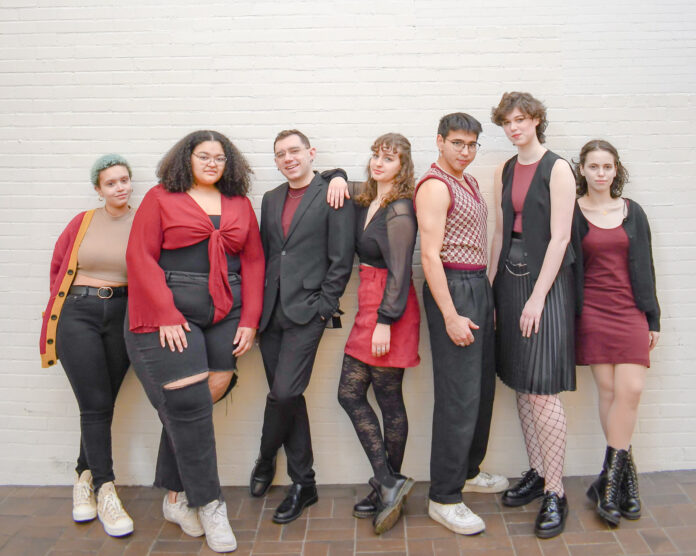The theatre department at Muhlenberg has been creating new experiences for students in the discipline. This past weekend, these new projects culminated into Co-Lab, a fully comprehensive course that Muhlenberg offered this semester. Co-Lab started in December of last year, where all three production teams had to propose what shows they wanted to put on as part of the course. In addition to the proposals, the individual production teams had to give draft ideas, costume ideas, etc. After that, their ideas could be chosen as a Co-Lab production, which was the culmination of their work in the course.
To participate in Co-Lab, students did not have to be enrolled in the actual course. All students who were enrolled in the course were a part of one of the productions.
The three final productions were “At the Heart of it All / At the End of the Line,” “…Even in Another Time,” and “Tartuffe! Kiss My Ass!” While there were no hard rules regarding who could be a part of the production, as auditions were held for any students who wanted to get involved, the one departmental show per semester per student rule still applied since Co-Lab was a departmental production.
While class time was typically delegated to the creative process that is typically behind the scenes, all actual rehearsals for the productions happened outside of the designated class times in the latter half of the semester.
Since the productions took place in Studio 22, which is not typically a space that houses final productions, it allowed for the production teams to play with the space and really make it their own. The space transformed for each production. Studio 22 as a space also did not allow for sets to be permanent until the Wednesday before the performances began. Co-Lab had invited dress on Thursday, with shows taking place from Friday through Sunday.
All three productions were vastly different from one another, leaving the audience with a unique experience of seeing three productions all with distinct narratives. “At the Heart of it All / At the End of the Line” details the Greek myth of Orpheus and Eurydice, with the focus being on characters that have the spotlight stripped away from them in the original tale. “…Even in Another Time” is centered around a queer relationship between vampires that stands the testaments of the ages. “Tartuffe! Kiss My Ass!” is focused on a group of clowns and the consequences when an unknown variable becomes involved.
Though all three adaptations covered completely different subject matters, the inspiration from all three directors seemed to have a powerful connection to issues these students have found to be significant, and want to play with their surrounding narratives. Joey Marcacci ‘23 details the inspiration behind his piece, “Tartuffe! Kiss My Ass!” He said, “Moliere wrote Tartuffe as a commentary on religious hypocrisy taking place at the time. Inspired by his use of comedy and satire, I wanted to adapt the play to fit the current political commentary I intended to convey with the piece, while still staying true to the spirit of the original. As the original Tartuffe was intended to spark conversation about current issues and ways of thinking, I wanted to also replicate that as well with my adaptation.”
This was a course environment that I had not experienced before as working with the professor, Nigel, felt more like working with a mentor and creative director for a production than a professor for a class.”
-Joseph Marcacci ’23
Brayden Stallman ‘23 elaborated on his personal inspiration for “…Even in Another Time,” as well as what drew him to the story itself. “This pre-Dracula vampire novella starring a female vampire and a not-so-hidden queer romance at the core of it was something that my creative partner Amelie Parcanzy [‘25] and I really fell in love with. It really spoke to what is befalling queer, trans and female bodies in America the past year. The fear of female and queer sexuality is the core of the original text and we wanted to feature that in particular.”
Bridget Wiggan ‘23, found that her inspiration for “At the Heart of it All / At the End of the Line” stemmed from what was lacking. “I realized how little information I was able to gather about Eurydice in the background research I conducted and that bothered me. Because of this, I decided that my version of the story would focus on what’s missing from the myth: what happens to Eurydice between her death and Orpheus bringing his wife back to the Overworld? So that’s what I explored—with the addition of three characters who don’t exist at all in the original myth: Eurydice’s sisters.”
When asked to detail their favorite parts about the entire process, Wiggan discussed “The first day of tech was honestly my favorite part of the process, because I got to see the whole thing come together in ways that left me speechless. While I had been proud of the work I had done beforehand, that first day really helped me see just how beautiful the show I created was. Plus, I got to work with an amazing group of actors who asked questions I hadn’t thought of and made the piece into what it was. I couldn’t have done any of it without them.”
Stallman found that “The most fulfilling part of this process was being able to work with an incredible team. Bringing Amelie and Gretchen D’Amato [‘23] over from “Tick Tick Boom” with me to work together again, as well as getting to work with an amazing set of actors who were so willing to try new things and really dive into the material. A lot of our cast are not dancers and yet they were unafraid to push themselves as far as possible.”
From being a Co-Lab audience member to conversing with students involved in the productions, it is abundantly clear that Company Manager Elizabeth Vichness ‘25 and Visiting Assistant Professor of Theatre and Dance Nigel Semaj were beyond crucial in bringing the vision to the stage. Maracacci elaborated on just how integral Semaj was to the process, “Our incredible creative director, Nigel Semaj, supported us during the process and really helped me with the creative development of my piece. This was a course environment that I had not experienced before as working with the professor, Nigel, felt more like working with a mentor and creative director for a production than a professor for a class.”
The outpour of love and support from students involved in the productions, audience members, and other professors alike made it easy to see that the community surrounding Co-Lab fostered a creative environment that allowed students to truly create productions that spoke to them and that they felt passionate about designing.
Amy Swartz ‘26 is an English & creative writing and political science double major. She is a General Editorial Assistant, and is thrilled to be a part of such an amazing organization! Outside of the Weekly, you can always find her reading a new book, updating her Spotify playlists, or rewatching an episode of New Girl!























